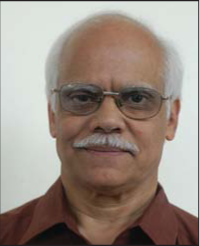Translate this page into:
S.K. Shankar (27 September 1947–5 September 2022)
Department of Pathology, Manipal Hospital, Yeshwanthapur, Bengaluru, Karnataka, India sanjayapai@gmail.com
[To cite: Pai SA. Obituary: S.K. Shankar. Natl Med J India 2023; 36:65-6. DOI: 10.25259/NMJI_400_2023]

On 5 September 2022, I sent Teacher’s Day wishes on WhatsApp to Professor S.K. Shankar. There was no response. A few hours later, someone informed me that Dr Shankar had passed away that morning. With his passing, truly, a colossus of neuropathology has left us. I must state that Professor Shankar was not ever my teacher in a formal sense. But everyone who interacted with him always learnt something from him. And it was not just pathologists, neurologists and neurosurgeons who benefited from his knowledge and his largesse; schoolchildren and researchers-past and future-fall into this list as well.
Shankar graduated from Andhra Medical College in 1969 and then did his MD in pathology at the All India Institute of Medical Sciences (AIIMS), New Delhi. After working there from 1974 to 1979, he joined the National Institute of Mental Health and Neurosciences (NIMHANS), Bengaluru, where he rose through the ranks and served in many roles including that of Professor, Dean, Acting Director and Vice Chancellor. In 2021, he suffered a stroke and was bed-ridden for the year after that. It was not easy for him—or his caregivers—as he felt stifled, as if under arrest. For a more detailed obituary, you would do well to read what his mentee, Anita Mahadevan has to say.1
His greatest contributions were the formation of the Human Brain Tissue Repository (‘Brain Bank’)2 where researchers could make use of fresh and fixed brain and related tissues for research. As is to be expected, Dr Shankar willed his own brain to the Brain Bank. The other concept dear to his heart was the Brain Museum (also the only such museum in India), which is open to the general public. Dr Shankar delighted in having schoolchildren visit the museum and see—and feel, with their own hands!—human brains (Fig. 1).

- Professor Shankar with a group of schoolchildren
If I saw an unusual pathology, or had a diagnostic problem related to neuropathology, I would send the slides to him for an informal opinion. His response, in each case, was prompt and complete in every aspect. When I emailed him about a mature ovarian teratoma that contained neural tissue, his reply to me had this statement ‘One needs to have an open mind and observe things as they appear. Biology is an open book.’ I had to occasionally request him to perform some immunostains, often gratis, for my cases, as I did not have access to those particular stains. One of them was particularly interesting.
In January 2017, I had seen an appendix, which seemed to resemble the features seen in lymph node toxoplasmosis. This was something that had not been reported in the literature, to my knowledge and was, quite honestly, an apparently bizzare diagnosis. I emailed Dr Shankar one morning and requested that he perform the stain for me, if only to satisfy my curiosity. He agreed to and called me up in the evening to say that he had seen the slide and did not agree with my diagnosis. However, the very next day, about noon, he phoned me and said: ‘Your immunostained slides are ready. This is toxoplasmosis. Please call up your patient immediately and ask him to come back to the hospital for treatment before the disease spreads to the heart or kidneys.’ We subsequently published this case.3 I wished to thank him, but he was clear: acknowledgments were to be given to the Brain Bank, not to him. This was in keeping with the philosophy of the man. He wanted the Brain Bank (and the Brain Museum) to achieve its potential in science, in education and in research; he was not interested in personal benefit or accolades.
I used to meet him once every year or two, when Professor Sunil Pandya would come to NIMHANS for a meeting. The three of us would meet for dinner at the NIMHANS guest house. It was probably on one of these occasions that we discussed the topic of genius in medicine and decided to write an editorial on it.4 After contributing intellectually to it, in person and on email, he chose, once again, to only be acknowledged because he felt he had not contributed enough to justify being an author. Both Dr Pandya and I thought that Dr Shankar was a genius and I stated so, in an email to him. His response: ‘I am not a genius, but a pathologist with curious and open mind.’
He was dedicated to science and to teaching; he was opinionated and probably not the easiest of colleagues to get along with—but he lived with malice towards none. As Dr Anita Borges (Pathologist, Mumbai) messaged me when I informed her the news about Dr Shankar’s death, ‘He did not have a single political bone in his body.’
References
- A tribute to the legend in neuropathology: Professor S.K. Shankar. Indian J Pathol Microbiol. 2022;65:970-3.
- [Google Scholar]
- Human brain tissue repository: A national facility fostering neuroscience research. Proc Natl Acad Sci India Sect B Biol Sci. 2014;84:239-50.
- [CrossRef] [Google Scholar]
- Toxoplasma appendicitis: A once-in-a-lifetime diagnosis! Int J Surg Pathol. 2018;26:89-92.
- [CrossRef] [PubMed] [Google Scholar]




